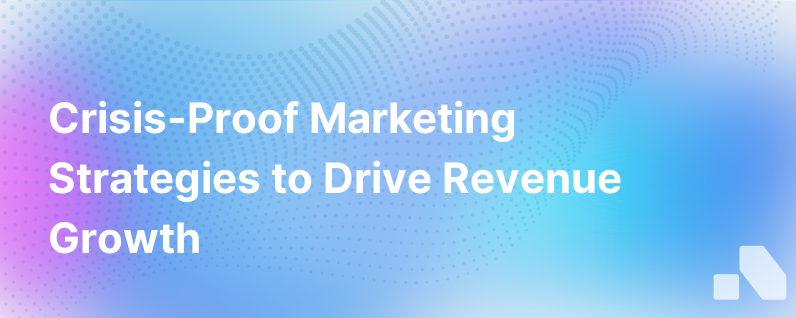
In times of crisis, when market volatility becomes a staple and budgets are scrutinized with a magnifying glass, it's essential for marketers to pivot swiftly and align their strategies more closely with revenue generation. Companies can't afford to view marketing as a discretionary spend; instead, they need to focus on revenue-driven marketing strategies that demonstrate tangible ROI.
This approach—often referred to as performance marketing—requires marketers to re-evaluate their campaigns, channels, and messaging to support the entirety of the buying cycle, driving leads that sales teams can convert into revenue. Let’s explore strategies for adapting your marketing to ride out the storm and contribute to your company's financial resilience.
1. Create Consistent and Meaningful Content
During a crisis, communication is more important than ever. Consistent and meaningful content can build trust and maintain relationships, even when spending slows down. High-quality content can attract, engage, and convert prospects, directly contributing to the revenue pipeline.
Actionable steps:
- Focus on problems that your products solve, particularly problems exacerbated by the crisis.
- Publish relevant thought leadership articles that address current challenges and offer actionable insights.
- Leverage SEO to improve organic reach and optimize your content for search intent related to the crisis.
2. Double Down on Account-Based Marketing (ABM)
ABM is a strategy where marketing efforts are concentrated on a clearly defined set of target accounts within a market. It delivers personalized campaigns that resonate with each account, based on specific needs and behavior of the account.
Actionable steps:
- Utilize data and analytics to identify key accounts that have a high propensity to buy during this time.
- Customize messaging and content to address the unique challenges these accounts are facing.
- Align closely with sales to identify opportunities for cross-sell or upsell within existing accounts.
3. Embrace Agile Marketing
Agility in marketing means the ability to quickly adapt to the changing needs of the market. This includes reallocating budgets away from low-performing channels and toward high-performing ones, experimenting with new messaging, and iterating rapidly based on performance data.
Actionable steps:
- Implement shorter campaign cycles to test, learn, and iterate quickly.
- Shift funds from underperforming channels into ones that are driving revenue, even if this means exploring new channels.
- Deploy quick feedback mechanisms like surveys to gauge customer mood and adapt strategies accordingly.
4. Invest in Marketing Automation and CRM Integration
Marketing automation tools can help you nurture leads efficiently and measure the direct impact of your campaigns on revenue. Integrating your CRM system with marketing automation ensures that sales and marketing stay aligned, which is crucial for an effective, revenue-driven approach.
Actionable steps:
- Use marketing automation to scale personalization across email, content, and social media campaigns.
- Set up lead scoring mechanisms to prioritize leads based on their likelihood to convert.
- Ensure seamless data flow between marketing automation tools and CRM to track leads through the funnel.
5. Optimize Digital Advertising for Conversion
Digital advertising can be an effective tool for lead generation, but in times of crisis, it's essential to optimize for conversion. This means re-evaluating keyword strategies, targeting, and bidding tactics to reduce costs and improve ROAS (Return on Ad Spend).
Actionable steps:
- Refine your PPC campaigns to focus on high-intent keywords and eliminate wasteful spend.
- Test and enhance your landing pages to improve conversion rates.
- Use retargeting campaigns to re-engage visitors who didn't convert the first time.
6. Leverage Video Marketing
Video marketing has a high engagement rate and can communicate complex messages in an accessible and human way - an invaluable asset in times of crisis when personal connection and empathy are needed.
Actionable steps:
- Create video content that delivers value, such as how-to guides or tutorials relevant to the current situation.
- Host live Q&A sessions or webinars to engage with customers in real-time.
- Utilize video content in email marketing campaigns to improve open and click-through rates.
7. Analyze Data and Metrics Relentlessly
You can't manage what you can't measure. In a crisis, the importance of closely tracking performance metrics that tie directly to revenue can't be overstated. This will allow marketers to pivot quickly and make data-driven decisions.
Actionable steps:
- Establish clear metrics for campaign performance that relate directly to revenue.
- Regularly review and analyze campaign data to identify trends and insights.
- Test everything—from headlines to call-to-action buttons—and let performance data guide your creative choices.
When the going gets tough, marketers must get going—not by doubling down on the usual, but by adapting, rethinking, and aggressively driving toward strategies that stabilize or grow the revenue base. During these periods, budgets may tighten, but opportunities also arise for those ready to seize them with nimble strategies and a clear focus on the bottom line.
In conclusion, during uncertain times, creativity and agility become the marketer’s best friends. By focusing on strategies that are tied to revenue—and by measuring, iterating, and scaling what works—marketing teams can go beyond brand-building and contribute directly to the financial health of the company. The result is not just survival through tough times, but emerging from them stronger and more aligned with the core business objectives. Remember, each industry has its own nuances when it comes to crisis management; always tailor these broad strategies to your specific situation—and to the unique needs and behaviors of your customers.
Return on investment (ROI) should be the north star of your marketing efforts in these times, and ultimately, it will guide your team to choices that preserve and even amplify company revenues. And when the dust settles, you'll find your marketing initiatives to be not just a cost center, but a revenue driver that weathered the storm and led your business into calmer seas.